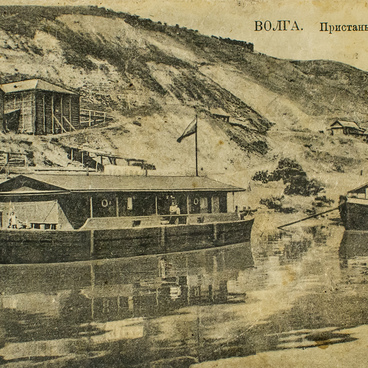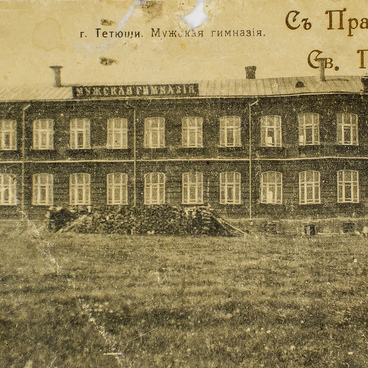At the end of the 19th century, numerous photo studios began to open all over Russia. Photographers specialized not only in portrait photography. Photographs of cities, villages, settlements, railway stations, bridges, piers, and buildings have been preserved to our day.
Open letters or photo postcards with views of the city of Tetyushi were published by Vasily Breev from Nizhny Novgorod, the Kazan publishing house “A. M. K”, the tobacco store D. Pappadato in Samara, and a resident A. Ibatullin — their full names are unknown. The author and publisher of the postcard presented in the exhibition are also unknown.
It shows a view of Malaya Troitskaya Street, which in the late 19th — early 20th century was one of the most populated streets of Tetyushi and was considered the hallmark of the county town.
A privately rented house on Malaya Troitskaya Street housed a male “mekteb”, a Muslim primary school. At the very beginning of the street was the white-stone Trinity Cathedral with golden domes.
According to the real estate tax bill of 1901, there were 132 houses in this area which is 40 percent of the citywide housing stock. There were mainly houses of the most affluent citizens on the streets. For example, the house of a merchant of the 1st guild, the owner of a roller mill, and a large grain merchant — Pyotr Kolsanov. He owned steamboats and a grain pier on the Volga and sold “krupchatka” (a special kind of flour) to Kazan, Rybinsk, and St. Petersburg.
In addition, on Malaya Troitskaya Street there were houses of merchants Maltsev, Serebryakov, Fokeyev, commoner Mikhail Shitukhin, and others. Twenty-four houses belonged to urban peasants and commoners. In the foreground of the postcard on the left is the house of merchant Egor Fokeev, and on the right is the dwelling of merchant Pyotr Kolsanov.
As in many small cities on the Volga, residential development in Tetyushi is concentrated in the historical center. This part of the city is divided into rectangular blocks. At the same time, the main streets leading out of the city: Lenin Street (before the revolution — Bolshaya Troitskaya) and Sverdlov Street (before the revolution — Malaya Troitskaya) cross the territory from south to north and end with an exit to the high bank of the Volga.
Open letters or photo postcards with views of the city of Tetyushi were published by Vasily Breev from Nizhny Novgorod, the Kazan publishing house “A. M. K”, the tobacco store D. Pappadato in Samara, and a resident A. Ibatullin — their full names are unknown. The author and publisher of the postcard presented in the exhibition are also unknown.
It shows a view of Malaya Troitskaya Street, which in the late 19th — early 20th century was one of the most populated streets of Tetyushi and was considered the hallmark of the county town.
A privately rented house on Malaya Troitskaya Street housed a male “mekteb”, a Muslim primary school. At the very beginning of the street was the white-stone Trinity Cathedral with golden domes.
According to the real estate tax bill of 1901, there were 132 houses in this area which is 40 percent of the citywide housing stock. There were mainly houses of the most affluent citizens on the streets. For example, the house of a merchant of the 1st guild, the owner of a roller mill, and a large grain merchant — Pyotr Kolsanov. He owned steamboats and a grain pier on the Volga and sold “krupchatka” (a special kind of flour) to Kazan, Rybinsk, and St. Petersburg.
In addition, on Malaya Troitskaya Street there were houses of merchants Maltsev, Serebryakov, Fokeyev, commoner Mikhail Shitukhin, and others. Twenty-four houses belonged to urban peasants and commoners. In the foreground of the postcard on the left is the house of merchant Egor Fokeev, and on the right is the dwelling of merchant Pyotr Kolsanov.
As in many small cities on the Volga, residential development in Tetyushi is concentrated in the historical center. This part of the city is divided into rectangular blocks. At the same time, the main streets leading out of the city: Lenin Street (before the revolution — Bolshaya Troitskaya) and Sverdlov Street (before the revolution — Malaya Troitskaya) cross the territory from south to north and end with an exit to the high bank of the Volga.



